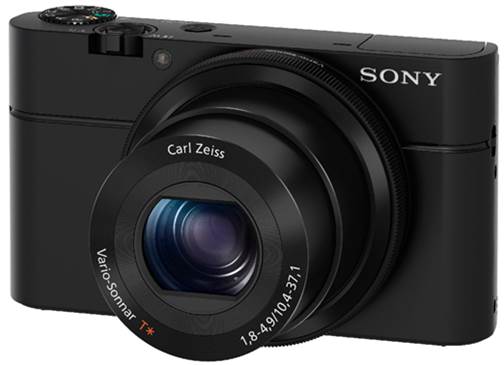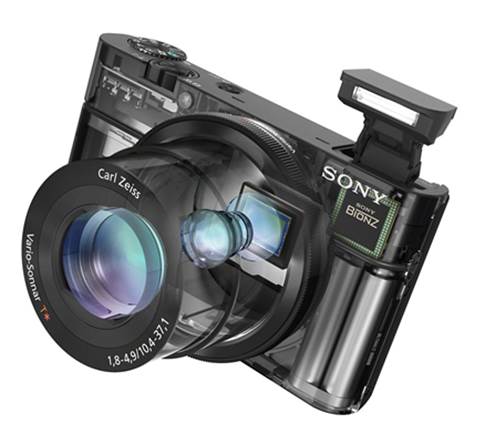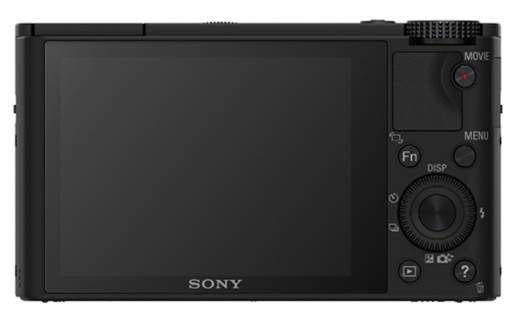Sony Cyber-Shot RX100
Features
The RX10D not only boasts the
highest-resolution sensor here, but also the largest. Its 20.2MP resolution
should in theory allow for more detail and better enlargements, although being
the second lightest on test may give it a disadvantage with regards to steady
handholding. Still, to ensure images are as sharp as possible. Sony has
equipped the 28-100mm optic with Super Steady Shot technology, and while the
impressively wide f/1.8 aperture at the wide end should also help in this
regard, its tailing off to f/4.9 at the 100mm ENC is a pity. Images are
recorded to both Raw and JPEG formats, while control over exposure is also
possible through full HD video recording. The 3in White Magic LCD screen boasts
the highest resolution out of the septuplet of cameras here, with the
l.2million dots comprising an extra white dot for each RGB trio.

Sony
Cyber-Shot RX100
Design
Slightly thicker than the XF1 but overall
still the most compact camera here, the RXIOO has decidedly few external
controls, and those that are present are definitely on the small side. The rear
is dominated by the 3in LCD screen, although in addition to the key controls
present, it’s nice to see enough space has been left for a small menu pad dial
and thumb rest. It’s impressive to think that the smallest camera here not only
sports the largest sensor but still manages to squeeze in a respectable 28mm
start on its lens. Less impressively, although the aluminum body gives the
impression of strength, as soon as the power button is pressed the slight give
around this area is noticeable. The lens’s control ring moves fluidly, though,
but its shallow profile may make it awkward for users with larger-than-average
hands.

It’s
impressive to think that the smallest camera here not only sports the largest sensor
but still manages to squeeze in a respectable 28mm start on its lens.
Image Quality
As the resolution charts show, not only is
the RX100 capable of resolving more detail than the other cameras here, but it
manages to maintain this excellently at high ISOs. Correct focus and
appropriate shutter speeds, however, become more critical, as the higher
resolution means that smaller inaccuracies are more easily spotted when images
are viewed at 100%. While some corner softness is visible at wider apertures, the
lack of distortion from the lens is surprising. The metering system is also one
of the most reliable on test, although AWB performance under artificial light
could be improved. Colors are generally neutral rather than vibrant.
Performance
The RX100 has a marginally slower start-up
time next to the other compacts here, despite it not being terribly slow in
itself. It can take a while for the camera to power down when writing images,
though, which makes putting it away quickly a touch more inconvenient, but its
shot-to-shot times are excellent. The focusing system is also impressively
prompt and reasonably discreet, although in quieter conditions the whirring of
the lens as it zooms through its focal range can hamper discreet shooting. The
screen is of a high standard though, with excellent detail and fine contrast,
while face detection works well to identify subjects.

The
screen is of a high standard though, with excellent detail and fine contrast,
while face detection works well to identify subjects
Key Specs
§ SENSOR :
20.2MP. lin type CMOS sensor
§ LENS:
28-100mm f/1.8-4.5
§ DISPLAY:
3in TFT LCD. 1.229k dots
§ ISO:
125-MOO (exp. io 80-100 and 25.600 equivalents)
§ EXPOSURE
MODES: iAuto, iAuto- PASM, scene
§ MOVIE
MODE : 1920x1080 50fps, 1443x1080 50fps
§ WEIGHT:
240g
§ DIMENSIONS:
101.6 x 58.1 x 35.9mm
Value
Although the seven compacts here all safely
fall into the enthusiast compact category, their asking prices stretch a wide
range from just over $512 to $800. While some are quite evidently better than
others in certain areas, it’s not true to say that a higher asking price
necessarily reflects a better performance. The cheapest camera of the lot, the
Fujifilm XF1, has an distinctly individual design and slips into the pocket far
easier than almost all the others, but its low price is easily explained by many
factors: it’s screen is the worst and its video quality is poor, and it
resolves less detail than the others. Yet, the next priciest camera,
Panasonic’s LX7, has a screen and video mode which easily rivals the more
expensive models here. The Samsung EX2F’s image quality is lackluster, although
for those shooting at lower sensitivities and keen on using its wireless
functionality it may be deemed good enough. The $672 Olympus XZ-2 is also a
mixed bag, with a fast AF system and lovely screen let down by mediocre image
quality and a confusing menu. While the Canon G15 is a fine performer, with
detailed images, an excellent video mode and fast AF, even these plusses can’t
quite justify its $800 asking price. True, the Sony RX100 is only slightly
cheaper, though this is understandable when the larger sensor, higher
resolution and excellent detail retention at higher ISOs are considered. In
terms of value it’s perhaps the LX7 and the Nikon P7700 which stand out, with
the latter being the best all-round performer.
Each camera impresses in some respect,
although with more competitors than before, each needs to or more to stand out
from the herd. When the key needs of the target market are considered, two
cameras stand out for the wrong reasons: the EX2F for its poor high ISO
performance and slow write times, and the XF1 for its lesser-resolving sensor
and low-quality LCD. This s a shame as both cameras have a number of
advantages, but the fact remains that for similar money better options exist.
The P7700’s slow write times are likewise disappointing, but it redeems itself
in many other areas, from its image quality through to its handling (its chunky
grip and plethora of direct controls certainly make it the best option for
those wanting a DSLR-like shooting experience). The LX7 is one of the
better-value options when its build, video quality and general performance are
weighed up against its price, but it’s bettered for resolution and handling by
some of the other options. Conversely, the XZ-2 is perhaps the best option for
spontaneous captures and awkward-angle shooting, but its $672 asking price is
steep. To some, the RX100 may seem to be the antithesis of an enthusiast
compact, given its lack of physical controls and a grip True, it’s bettered by
other cameras in some areas, but the combination of its general performance,
image quality and size make it the most appealing camera of the seven. Overall,
if money is no issue and image quality is a priority, the RX100 is the
recommended buy. If video quality and a more DSLR-like handling are priorities
then the G15 is a better choice, while the P7700 deserves a highly commended
badge for delivering impressively on practically all counts for significantly
less at just $640.